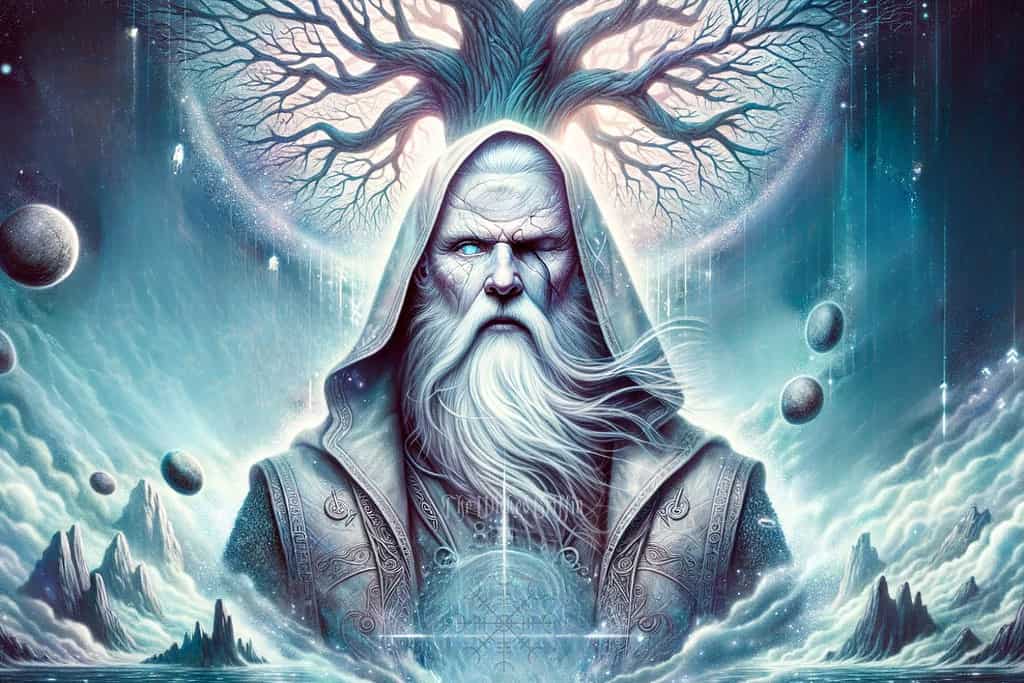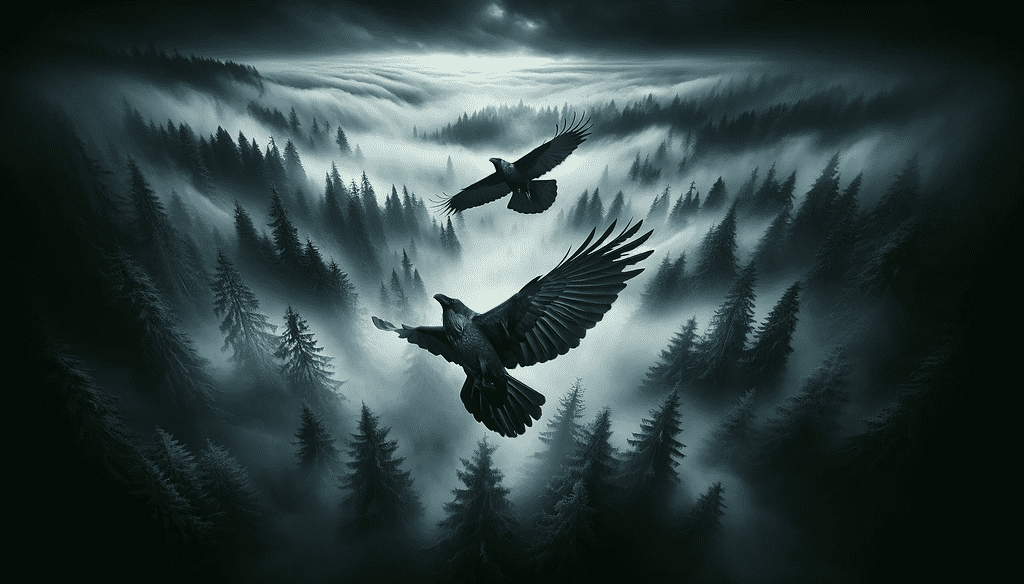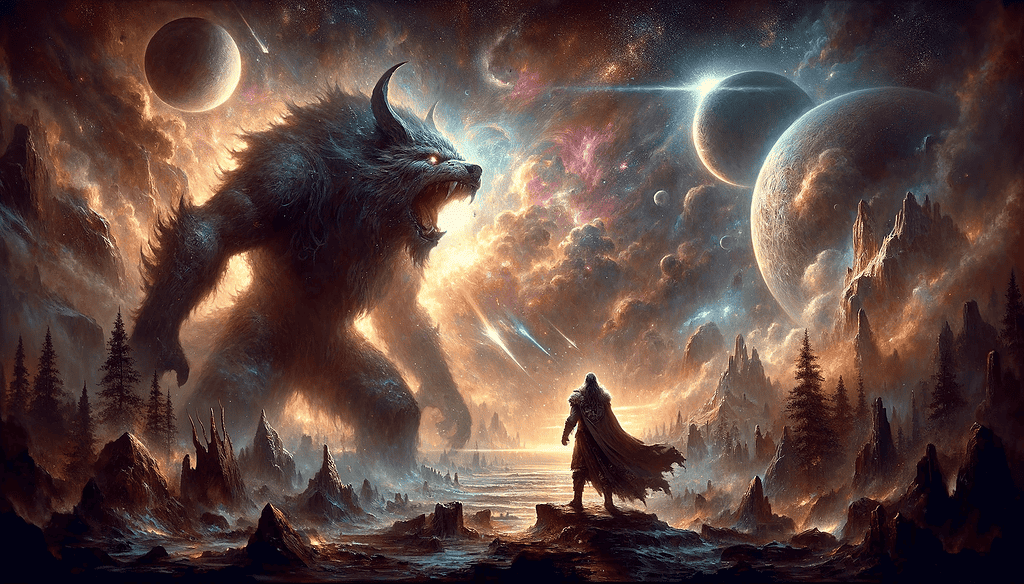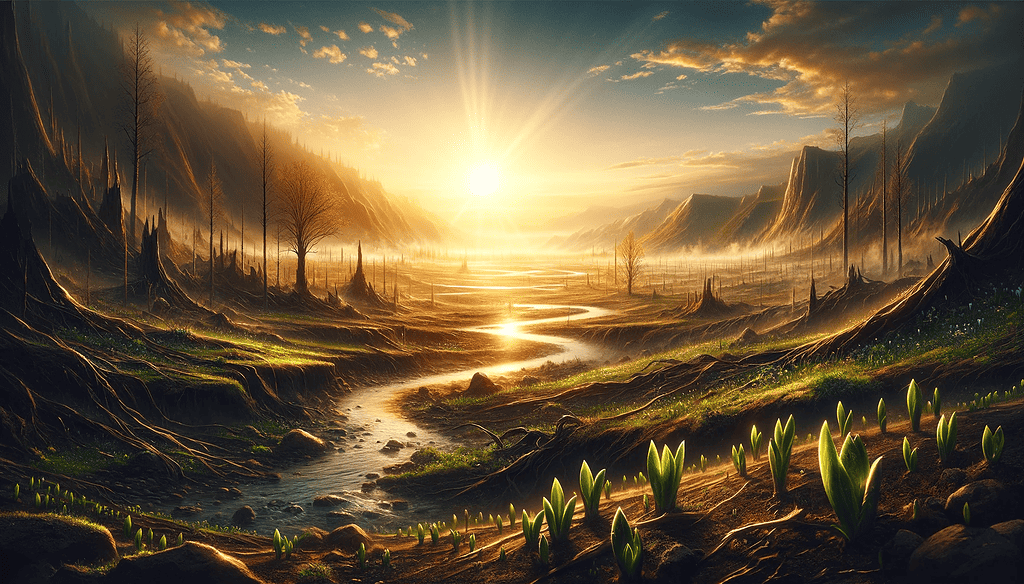No products in the cart.
March 27, 2024 2:13 pm
March 27, 2024 2:13 pm
Norse mythology, with its intricate web of gods, giants, and heroes, has fascinated minds for centuries and continues to captivate the modern imagination. At the heart of these ancient tales stands Odin, the All-Father, whose wisdom and exploits are central to Norse cosmology.
This article invites you on a journey to explore the profound narrative of Odin’s ultimate fate during the cataclysmic events of Ragnarök.
Engaging with this saga offers a unique lens through which to view the rich heritage of Norse mythology, resonating deeply with enthusiasts of Scandinavian folklore and paganism alike. Let us embark on this voyage through the mist-shrouded realms of the Norse pantheon, rediscovering the timeless tales that continue to inspire and intrigue today.

Odin, the All-Father, stands as a pillar of complexity and depth within Norse mythology. His dominion stretches across the realms of wisdom, battle, and the realm of death, making him one of the most revered and multifaceted deities in the Norse pantheon.
As the king of the Norse gods, Odin’s thirst for knowledge is matched only by his prowess in battle.
He is known for his relentless pursuit of wisdom, often sacrificing his own comfort and well-being, such as when he traded an eye for a drink from the Well of Mimir.
This insatiable quest for understanding is coupled with his role as a warlord, where he guides and selects fallen warriors to join him in Valhalla, preparing for the prophesied final battle of Ragnarök (Davidson, 1993, pp. 75, 76).
The symbols associated with Odin offer a window into his vast influence and the values he embodies.
Sleipnir, his eight-legged horse, symbolizes not just swiftness and reliability but also the ability to traverse the challenging landscapes between worlds, embodying Odin’s role as a boundary-crosser and a shaper of destinies.
The wide-brimmed hat and cloak are not just for anonymity but also serve as a mark of his wanderer aspect, a god in constant search for knowledge and insight, moving incognito among the realms of gods and men.
These symbols, integral to understanding Odin, paint a picture of a god who is not just a ruler but a seeker, a warrior, and a sage, deeply intertwined with all facets of existence in the Norse universe.

Within the vast and vivid tapestry of Norse mythology, few symbols are as emblematic of Odin’s multifaceted nature as his raven companions, Huginn (Thought) and Muninn (Memory).
Perched upon the All-Father’s shoulders, these birds serve not merely as his loyal companions but as extensions of his very essence, flying across the realms each day to gather information and return by evening to whisper the secrets of the world into his ears.
The presence of Huginn and Muninn underscores Odin’s dominion over mind and memory, crucial attributes for the god of wisdom and war.
Their daily flights represent the ceaseless quest for knowledge, a core aspect of Odin’s character, and a reflection of the Norse cultural value placed on wisdom and foresight.
Moreover, the ravens’ roles highlight the interconnectedness of thought and memory in shaping wisdom; one cannot exist without the other, and both are essential for making informed decisions and understanding the world (Davidson, 1993, p. 77).
Their symbolism extends beyond the personal to the universal, embodying the Norse understanding of the cosmos as a place of constant change and movement.
Just as the ravens traverse the nine realms, so too does knowledge flow and evolve, never static, always expanding.
This dynamic process of learning and remembering is mirrored in the practices of Norse paganism and the study of Norse mythology, where devotees seek to connect with the ancient wisdom through the stories and symbols passed down through generations.
For practitioners of Norse paganism and enthusiasts of Viking lore, Huginn and Muninn serve as powerful reminders of the importance of both seeking out new knowledge and cherishing the wisdom of the past.
Their inclusion in Odin’s mythology invites reflection on the balance between exploration and preservation, urging a mindful engagement with the world and its many mysteries.

As we delve into the intricate narrative of Ragnarök, it’s essential to understand the key figures who play pivotal roles in this cosmic drama. As scholar Hilda Davidson (1993) writes, Ragnarok is a transformative event that impacts all of the Norse Gods.
The table below serves as a guide to the gods of Norse mythology, delineating their affiliations to the Aesir or Vanir tribes, their roles within the mythos, and their ultimate fates as foretold in the sagas.
This snapshot offers a clearer perspective on the interwoven destinies of these deities as we explore the cataclysmic events leading to the end of the old world and the dawn of a new era.
| Norse God | Tribe | Role & Connection | Fate at Ragnarök | Family Relation |
|---|---|---|---|---|
| Odin | Aesir | All-Father, god of wisdom, war, death | Slain by Fenrir | Father of Thor, Baldr, Víðarr, Váli; Blood brother to Loki |
| Thor | Aesir | God of thunder, protector of Asgard | Dies fighting Jörmungandr | Son of Odin and Jörd |
| Freyr | Vanir | God of fertility, prosperity, fair weather | Killed by Surtr | Brother of Freyja |
| Loki | Jötunn (associated with Aesir) | Trickster, instigator of Ragnarök | Fights against the gods | Father of Fenrir, Jörmungandr, Hel; Blood brother to Odin |
| Heimdallr | Aesir | Watchman of the gods, guardian of Bifröst | Kills and is killed by Loki | – |
| Fenrir | Jötunn | Monstrous wolf | Slays Odin, killed by Víðarr | Son of Loki |
| Jörmungandr | Jötunn | Midgard Serpent | Kills and is killed by Thor | Son of Loki |
| Baldr | Aesir | God of light, purity | Dead before Ragnarök; Returns afterward | Son of Odin and Frigg |
| Vidarr | Aesir | Silent god, avenger of Odin | Kills Fenrir | Son of Odin |
| Surtr | Jötunn | Fire giant, enemy of gods | Destroys world with fire, kills Freyr | – |
| Tyr | Aesir | God of war and justice | Dies fighting Garm | – |
| Bragi | Aesir | God of poetry and music | – | – |
| Idunn | Aesir | Keeper of apples of youth | – | – |
| Frigg | Aesir | Goddess of marriage, motherhood | – | Wife of Odin, mother of Baldr |
| Freyja | Vanir | Goddess of love, beauty, fertility | – | Sister of Freyr |
| Njord | Vanir | God of sea, wind, fishing | Survives Ragnarök | Father of Freyr and Freyja |
| Skadi | Jötunn (associated with Aesir) | Goddess of skiing, winter | – | – |
At the heart of Norse cosmology lies Yggdrasil, the World Tree, a colossal ash tree that connects all of existence within its branches and roots. This cosmic tree holds the Nine Realms, each a unique world inhabited by gods, humans, giants, and other beings.
Among these realms are Asgard, the home of the Aesir gods; Midgard, the world of humans; Jotunheim, the land of giants; and Helheim, the realm of the dead.
Yggdrasil as a world tree that acts also as a gateway to the nine worlds of the Norse cosmovision reveals striking similarities to northern Eurasian shamanic lore (Davidson, 1993, p. 69).
Yggdrasil’s roots delve into well-springs of profound knowledge and fate, tying the gods and their destinies to the wider universe.
Understanding Yggdrasil and its realms is essential for grasping the interconnectedness of all things in Norse myth, setting the stage for the epic narratives that unfold, particularly the saga of Ragnarök.

Ragnarök, often referred to as the Twilight of the Gods, is the foretold apocalypse within Norse mythology, a series of events leading to the death of major gods, including Odin, Thor, and Freyr.
This cataclysm is marked by a great battle, preceded by a harsh winter that lasts for years, leading to widespread strife and the breakdown of social orders.
During Ragnarök, it is said that the great wolf Fenrir will break free from his chains to devour Odin, and the Midgard Serpent will rise from the ocean depths to unleash chaos.
The world will be consumed by fire, only to be reborn anew, fresh and fertile for the surviving gods and humanity.
Ragnarök encapsulates the Norse belief in cycles of destruction and renewal, emphasizing that from the ashes of the old, a new world can emerge.
This concept of an ending followed by a new beginning is pivotal for understanding the Norse view of time, destiny, and the interconnectedness of all life, bound by the roots and branches of Yggdrasil.
It is quite different from the Christian idea of Armageddon or the Apocalypse and it is of importance to not see Ragnarok through the lens of a biblical worldview.
Through the story of Ragnarök, we gain insight into the Norse perception of fate, where even the gods are subject to the inexorable march of destiny, woven by the Norns at the base of the World Tree.
The shadow of Baldr’s death looms large over the Norse cosmos, marking a turning point toward the inevitable end of the world. Baldr, the son of Odin, known for his purity and light, met his untimely demise through a plot most foul, orchestrated by the trickster Loki.
This event not only shook the foundations of Asgard but also deeply affected Odin, the All-Father, who foresaw the loss of his beloved son as the first in a series of catastrophic events leading to Ragnarök.
Baldr’s death symbolized the extinguishing of the brightest light in the Norse pantheon, casting a long shadow on the gods and signifying the beginning of the end.
The Aesir-Vanir War stands as a testament to the deep-seated conflicts and complexities within the divine families of Norse mythology. This war, which occurred long before the events leading directly to Ragnarök, set the stage for future discord among the gods.
The Aesir, led by Odin, and the Vanir, known for their connection to fertility and wisdom, clashed in a conflict that ultimately ended in a truce, with hostages exchanged between the two clans.
This historical tension sowed the seeds of distrust and rivalry, underscoring the fragile alliances within the Norse pantheon and highlighting the multifaceted nature of divine politics, which would later play a significant role in the events leading up to the cataclysmic end.
In a quest for knowledge of his fate and the fate of the worlds, Odin sought the wisdom of the Volva, a seeress of great power, as recounted in the Poetic Edda.
Her prophecy foretold the fall of the gods and the destruction of the world in stark detail, including the death of Odin at the jaws of the giant wolf Fenrir during the final battle of Ragnarök.
This moment, laden with foreboding, reveals Odin’s relentless pursuit of understanding, even at the cost of facing his own demise.
The prophecy of the Volva serves as a pivotal moment in Norse mythology, outlining the events that would lead to the end of the age of gods and the birth of a new world from the ashes of the old.
Odin’s consultation with the Volva underscores his role as a seeker of wisdom and his acceptance of fate, embodying the Norse belief in the inexorable march of destiny.
The tapestry of events leading to Ragnarök is woven with threads of destiny and doom, prominently featuring the tragic death of Baldr, Odin’s beloved son. Baldr’s demise, caused by the mischievous Loki’s machinations, was the first of the omens that foretold the coming of the end times.
Despite the gods’ efforts to protect Baldr, their oaths were broken, and trust among them shattered, setting the stage for the eventual unravelling of the world.
This period was marked by a chilling Fimbulwinter, a great winter that lasted three successive years without a summer, leading to widespread despair, moral decay, and the erosion of the bonds that held societies together.
These dark times underscored the fragile nature of fate and the interconnectedness of all beings in the Norse cosmos, echoing the inevitability of Ragnarök.
As the prophesied doom of the gods dawned, Odin, the god of wisdom and war, prepared for his final stand. The fields of Vigrid were set as the stage for this cataclysmic battle, where gods and monsters clashed in a fight for the very essence of existence.
Among the chaos, Odin faced his destined adversary, the great wolf Fenrir, a monstrous beast whose jaws were wide enough to swallow gods.
Odin, known for his foresight and wisdom, had long anticipated this moment, yet the outcome was bound by the threads of fate, unchangeable even by the king of the gods.
The battle was fierce and echoed the clashing of primal forces. Odin, astride his mighty steed Sleipnir, wielded his spear Gungnir with unmatched skill, a symbol of his authority and prowess in battle.
Despite his power and the rallying of his sons and warriors, the prophecy held true. Fenrir’s gaping maw closed around Odin, marking the death of the All-Father and signifying a pivotal moment in the cosmic cycle.
This event was not just the fall of a god but a signal for the beginning of the end, as foretold in the ancient texts of the Poetic and Prose Edda (Davidson, 1988, pp. 191 – 194).
Odin’s demise at the jaws of Fenrir was a moment of profound significance, representing the cyclical nature of Norse mythology, where destruction paves the way for renewal.
In the aftermath of this great battle, a new world was prophesied to rise from the ashes of the old, a testament to the resilience of life and the enduring legacy of the Norse gods.
Odin’s sacrifice, like the fall of the other gods during Ragnarök, was seen as a necessary passage to usher in a reborn world, purified and ready to begin anew.
This tale, steeped in the lore of the Poetic Edda and reflected upon by scholars such as Snorri Sturluson, continues to captivate those drawn to the myths of the Norse and the sagas of its gods and heroes.

In the smoldering aftermath of Ragnarök, the cataclysm that saw the fall of the old gods and the burning of the world, a new realm arose from the sea, untouched and verdant.
This rebirth of the world is a cornerstone of Norse cosmology, illustrating the cycle of destruction and renewal that permeates the universe. The surviving gods, along with a new generation of beings, found this world ripe for the sowing of future destinies.
Among the emerald fields of this nascent earth, the sons of Odin and other gods discovered the chess pieces left by their forebears, symbolic of the wisdom and strategies of the old world that would inform the new.
This new world was not a mere continuation of the old but a place of renewed hope and potential, embodying the resilience inherent in the Norse understanding of fate.
Though Odin fell in battle with the great wolf Fenrir, his legacy did not perish with him.
The All-Father’s quest for wisdom, his sacrifices for knowledge, and his indomitable spirit continue to echo through the ages, inspiring those who seek to understand the depth of Norse mythology and its implications for life’s perennial questions.
Odin’s wisdom, encapsulated in the runes and the mead of poetry, remains a beacon for scholars, practitioners of paganism, and those drawn to the mystique of the Viking age.
His role in shaping the cosmos, from the creation of the world from Ymir’s body to the establishment of the human realm of Midgard, underscores his significance as a central figure in the Norse pantheon.
The mythic narrative of Odin’s life and death, as chronicled in the Poetic Edda and the Prose Edda by Snorri Sturluson, serves not only as a testament to his complexity as a deity but also as a reflection of the values and beliefs of the Germanic peoples.
His willingness to sacrifice his eye for insight at the Well of Mimir, and his self-hanging on Yggdrasil, the World Tree, for the secrets of the runes, exemplify the virtues of wisdom and sacrifice that were held in high esteem.
These stories, rich with symbolism and allegory, continue to influence modern interpretations of Norse culture, from literature and film to the practices of modern Norse pagans and Heathens.
Furthermore, Odin’s multifaceted character as a war god, a god of death, and the chief of the Aesir gods, illustrates the intricate tapestry of roles and responsibilities attributed to the Norse deities, reflecting the complexities of life itself.
His relationships with other gods, his adventures, and his ultimate sacrifice in the face of Ragnarök offer profound insights into the nature of leadership, the pursuit of knowledge, and the acceptance of fate’s inexorable march.
In contemporary culture, Odin’s mythology has found new life, resonating with those who seek connection with ancient wisdom and the natural world.
His representation as a wise old man, a powerful god, and a pivotal figure in the events of Ragnarök speaks to a universal archetype that transcends cultural and temporal boundaries.
The resurgence of interest in Norse myths, driven by literary sources and popular media, has brought Odin’s stories to a new audience, sparking a renaissance of interest in Norse heritage and spirituality.
The enduring fascination with Odin and the Norse gods underscores a broader cultural yearning for narratives that embrace the cyclical nature of existence, the value of wisdom, and the importance of facing one’s destiny with courage and honor.
As the central figure in many of these tales, Odin’s legacy continues to inspire and challenge, inviting us to explore the depths of our own understanding and to find meaning in the myths that have captivated the human imagination for centuries.

The saga of Odin and the panoramic events of Ragnarök offer more than just tales of valor and the inevitable cycle of destruction and rebirth.
They serve as a conduit for timeless wisdom, reflecting on themes of sacrifice, wisdom, fate, and the perpetual quest for understanding.
Odin’s life, filled with quests for knowledge, even at great personal cost, and his stoic acceptance of his prophesied demise, invites us to ponder the value of wisdom and the inevitability of change in our own lives.
The narratives woven around the Norse gods, particularly Odin, encapsulate a rich tapestry of beliefs and values that resonate deeply with modern seekers of wisdom and truth.
The multifaceted nature of these deities, their virtues, and their flaws mirror the complexities of human life, offering a reflection on the balance between destiny and free will, strength and wisdom, chaos and order.
For enthusiasts of Norse mythology, pagans, and those drawn to the mystical realms of the Vikings, the stories of Odin and the cataclysmic Ragnarök are not merely ancient myths but are imbued with lessons and insights that are remarkably pertinent to contemporary life.
They encourage a deeper engagement with the world, a thoughtful reflection on our own beliefs and actions, and a respectful acknowledgment of the forces of nature and fate that shape our existence.
In delving into these ancient sagas, we are reminded of the enduring power of storytelling and mythology to guide, inspire, and challenge us.
As we navigate the complexities of modern life, let the wisdom of Odin and the tales of the Norse gods illuminate our path, encouraging us to embrace the lessons of the past as we forge our own destinies in the present.
References and further reading:
Davidson, D. H. E., Davidson, H. E. (2002). The Lost Beliefs of Northern Europe. United Kingdom: Taylor & Francis.
Davidson, H. R. E. (1988). Myths and Symbols in Pagan Europe: Early Scandinavian and Celtic Religions. United Kingdom: Manchester University Press.
Check out these other categories: